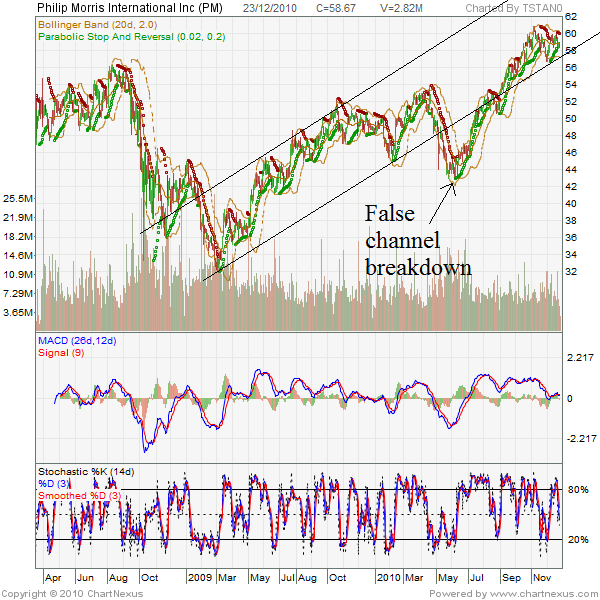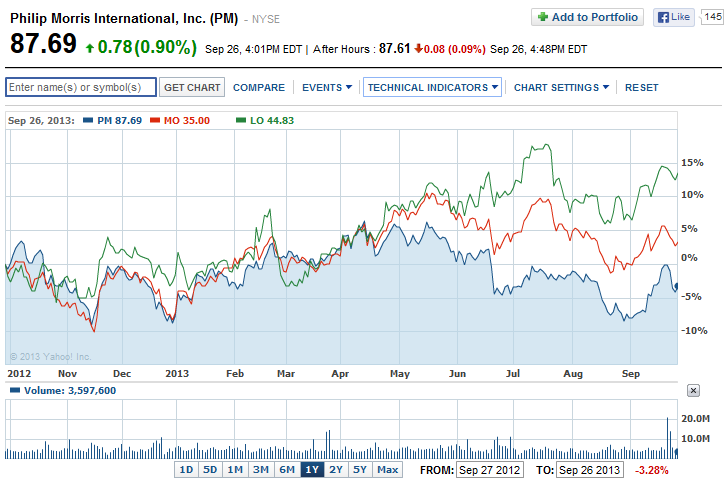Philip Morris Stock Analysis Philip Morris International Inc (NYSE PM)
Post on: 21 Май, 2015 No Comment

Looks like I have a little capital from my recent ARCP sale to deploy, so I wanted to take this opportunity to research a potential investment for the excess capital. For me, it was a no-brainer figuring out which stock I was going to analyze. Tobacco has a relatively low weight in my portfolio even though the power companies in the industry offer very attractive yields. With stock prices falling lately, it seemed like a great time to assess my only tobacco holding, Philip Morris (NYSE:PM ), to determine if I should re-up my position.
Who is Philip Morris?
PM is an international cigarette company, with the three largest revenue regions consisting of Europe, Asia and Middle East/Africa. PM’s brand portfolio consists of some pretty big names in the industry, holding brands such as Marlboro, Parliament, L&M, and of course, Philip Morris. In 2008, PM was spun-off from Altria Group (NYSE:MO ), which decided to separate its international and domestic business operations. Now, PM sports the largest market cap in the cigarette industry, sporting a market cap of over 128.1B. The next closest companies are MO,
$108b, and BTI,
$104.1b.
Share Repurchase Program
Even though we focus on dividends in this blog, another great way for a company to provide shareholder value is to repurchase some of their current outstanding stock. As we discussed at length in a post a few months ago. a company can use share buyback programs as a means to reduce their share count, increase their EPS, and lower their payout ratio. Thus, buyback programs can provide room for companies to continue to grow their dividend for years to come. For PM, in 2012, the company announced a share repurchase program committing $18b to repurchase shares over three years. Through the 4th Quarter of 2014, PM has spent $12.6 billion to repurchase shares based on their recent earnings release, meaning the company still has $5.4b worth of shares to repurchase under the program. However, during their most recent earnings release, management stated that due to market pressures, the company will not repurchase any additional shares during 2015. This is unfortunate, especially considering how beneficial stock repurchase programs can be for dividend investors, because $5.4b in shares to repurchase this year, which could potentially repurchase
65.5m shares, increasing EPS from $4.76 to
$5.19, and lowering the payout ratio to 77%. If the pressures turn out to be short term in nature and the market conditions improve, management can always decide to repurchase shares under their current program (which they emphasized in the release). Hopefully, that is the case and us shareholders will get a boost later on in the year.
Dividend Diplomats’ Stock Screener
It is unfortunate that PM has suspended its buyback program; however, it is understandable in the current environment. With that being said, it is time to run PM through the Dividend Diplomats’ stock screener to see if the company hits our three basic investing pillars. Of course, we have added some additional tests along the way to further help us with our decision, so we will see more than three tests below. For the purposes of our screener, we will compare PM to competitors Altria Group and British International (NYSEMKT:BTI ). Let’s see how the companies performed in our screener.
- P/E Ratio — Our first test is to assess whether the P/E Ratios are less than the S&P 500 ratios. For our analysis, we will use the forward P/E ratios, which are based on an average estimated earnings for the year. Currently, the S&P 500’s forward P/E ratios is

17. Based on the table below, BTI is the only one of the three companies to have a forward P/E less than the S&P. This is very interesting as I was expecting PM to have the lowest of the group.
Summary
I am a little surprised by the results of the analysis, considering I was expecting PM to perform well in our screener. However, based on the results of the screener, PM does not pass our screener as the company failed both the P/E Ratio and payout ratio screens. The bigger question is should I consider purchasing BTI over PM? After all BTI would provide me with the same international tobacco exposure as PM and the company performed better in our stock screener. Regardless, since neither PM, BTI, or MO passed all three metrics of our stock screener, I will not be purchasing their shares with my excess capital. Going forward, I will add PM and BTI to my watch list to see if the stocks depreciate and become a greater value.
What are your thoughts on the analysis? Have you purchased shares in PM, BTI, or MO recently? If so, why did you select one company over the other? Would you consider purchasing one of the stocks even though they have a high payout ratio? Please let me know your feedback of this analysis!
Since you’ve shown interest in PM, you may also be interested in














